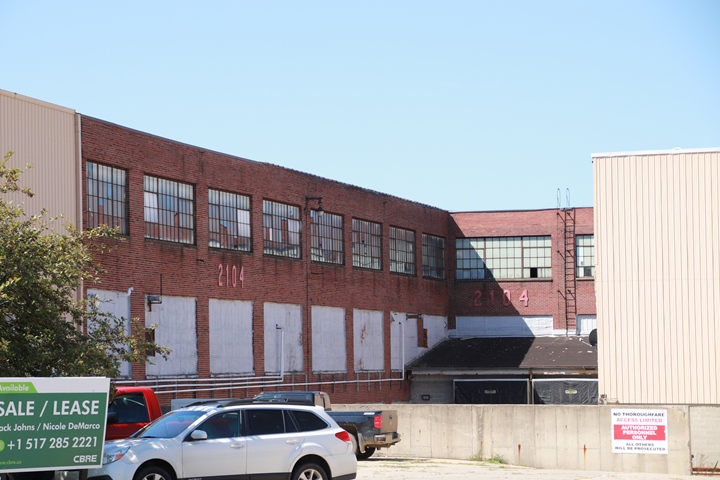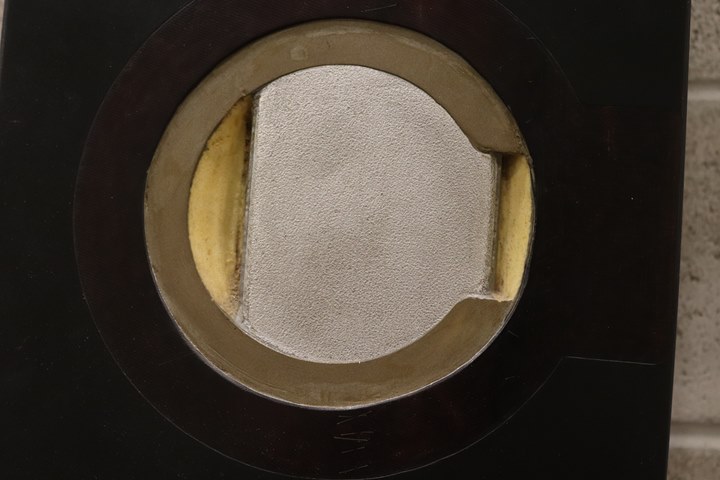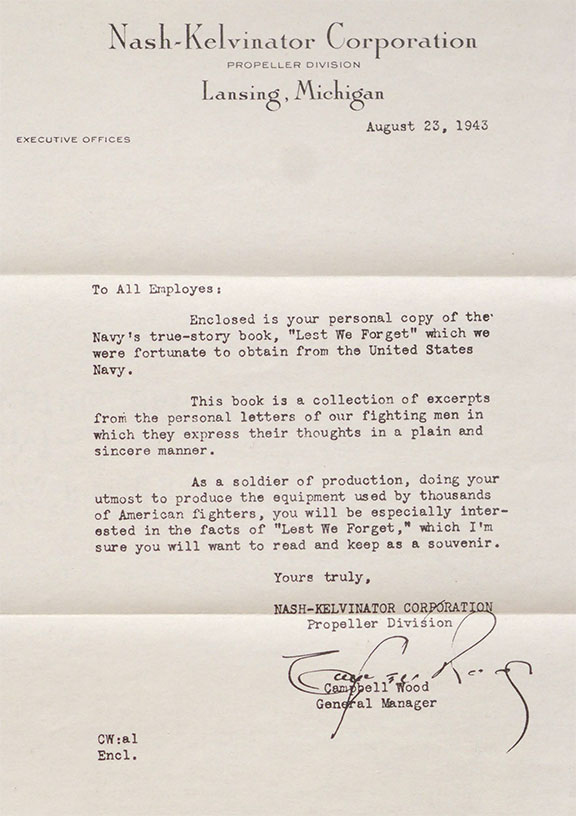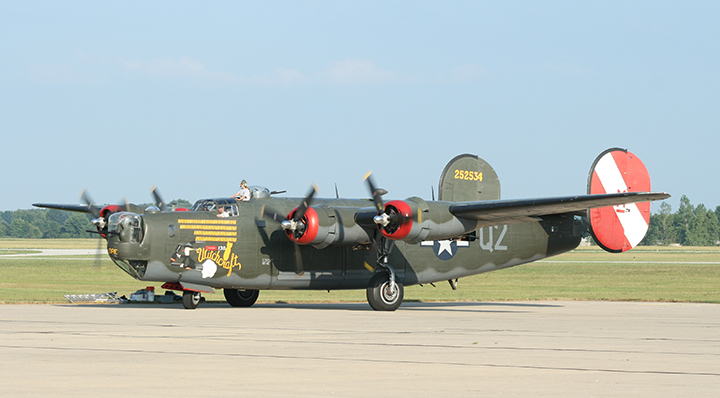|
Other Lansing Companies that contributed
to winning World War Two
Nash-Kelvinator Lansing Plants in World War Two
Recognizing a Company
from my Hometown that contributed to winning World War Two
Lansing, MI
1941-1945
This page updated 4-8-2022.
Nash-Kelvinator Lansing
Plant World War Two
Products:
158,134 three and four blade propellers and 85,656 spare blades.
Nash-Kelvinator Lansing was second in the amount of US propeller
production during the war. For the month of October 1943, Lansing
produced 7,015 propellers, more than any other manufacturer, making it
the world's leading propeller supplier for the month. The total
value of the Army Air Force contracts totaled
$539,433,000.

The Nash-Kelvinator Plant in Lansing, MI won
the Army-Navy "E" Award on September 17, 1943.
The Plants:
Nash-Kelvinator South Cedar Street
Plant in Lansing, MI:

This is Cedar Street in Lansing, MI looking
north with the former World War Two Nash-Kelvinator plant on the right. The three story building was originally built by Reo and connected to
its main assembly plant with pedestrian bridge over Cedar Street.
The Reo main plant is to the left in this photo and John Bean and former
Nash-Kelvinator propeller plant is on the right. The Defense Plant
Corporation purchased the 457,511 square foot three-story factory in
1940 and Nash-Kelvinator began producing Hamilton-Standard aircraft
propellers in it during 1941. In December 1945 John Bean purchased
the plant from the Reconstruction Finance Corporation. The plant
was located on 9.3 acres of land. This is how the plant looked
during World War Two. I am not sure why Reo even built the
three-story factory when it was continually having problems generating
enough truck sales to stay solvent.
This 1950 photo is looking north. I
do not remember the pedestrian bridge over Cedar Street. In the
background, the railroad crossing for the Grand Truck Railroad can be
seen. Cedar Street is the main north-south road running just
east of downtown Lansing and is a major traffic thoroughfare in the
city. To alleviate traffic backups, an overpass was built over the
tracks.

This is how I remember Cedar Street from when I
was growing up in Lansing. The former Reo, Nash-Kelvinator, and
John Bean plant is now occupied by Rehbel, a cultivator of cannabis .
According to its website, Rehbel considers itself the Jack Daniels of
the cannabis industry. With 10.5 acres on the three floors in the
building, the company has plenty of floor space to cultivate its
product. Author's photo added 9-12-2021.

I took this photo in 2011. The owners
of the building were then attempting to put lofts in it. Author's photo.

Ten years later, in 2021, the plant has added
some climate control units on the roof to maintain the proper
temperature in the building. Otherwise, it is pretty much like I
remember it when I grew up near here. I remember driving
by once and there was a red fire engine in this parking lot that John Bean
was working on. Author's photo added 9-12-2021.

Author's photo added 9-12-2021.

This is the east end of the current Rehbel
facility. Due to the topography, this section is only two stories.
Author's photo added 9-12-2021.

This Sanborn map shows the plant in 1951. The pedestrian bridge
over South Cedar Street is on the map. Image added 9-12-2021.
The first contract
Nash-Kelvinator
received at the plant came on June 28, 1941. It was for 5,000 propellers to be
delivered to the British government starting in 1942. These
propellers would have
been used on Lancaster, Mosquito, and Baltimore aircraft. First
production started in the 450,000 square foot facility in February of
1942, when the first propeller came off the assembly line and was
accepted by inspectors. The Defense Plant Corporation provided $8.5 million worth of
equipment for the manufacture of the propellers in the plant.
In October 1942
Nash-Kelvinator received a second contract from the Army Air Force for
7,000 propellers for its own use. Then, Nash-Kelvinator was issued
a third contract in May of 1942, which was the working contract that was
amended as the war progressed as more propellers were needed. In
March 1942 final assembly and blade manufacturing moved to the former
Duplex Truck plant at Mt.
Hope and Washington Streets, with the Cedar Street plant then
responsible for propeller hub production.
At its peak, the
Nash-Kelvinator Lansing operation employed 8,500 workers.
Nash-Kelvinator
final assembly plant on the southwest corner of Mt. Hope Avenue and
Washington Street in Lansing, MI:

This World War Two-era photo of the former
Duplex plant shows that has sections that parallel both Washington
Ave. to the left in the photo and Mt. Hope Ave. to the right. An
article from the Lansing State Journal dated 9-14-1917 states that the
400 foot main building was nearly complete. The article goes on to
state that the foundation would begin to be laid for a 240 foot building
to the south.
In December 1945 Motor
Wheel purchased this plant from the Reconstruction Finance Corporation
for the manufacture of it Duo-Therm oil heaters and water heaters.
I remember seeing a big Motor Wheel sign on the building while growing
up in the area. Then the sign went away. Apparently, the
Duo-Therm business was not as profitable for the company as expected.
Since there is no sign on the building and the vintage of the vehicles
in the photo, this appears to a World War Two photo. The street parking on Washington Avenue
is surprising to me. There was no parking on it when I grew up.
The next series of photos
was taken in 2011. The building's exterior has changed in some
ways. The brick along Mt. Hope Avenue has been painted and the
first floor windows covered up. Along the Washington Avenue side
of the building, the brick has been covered with sheet metal.

This view is looking at the former Nash-Kelvinator plant
from across the street on Mt. Hope Avenue. When in junior high
school, I would walk the sidewalk in the foreground, not realizing the
significance of the plant across the street or that my grandfather had
worked there during the war. While in college, I would drive this
route to Michigan State University.
Author's photo.
The plant became the final assembly location for Nash-Kelvinator
starting in March of 1942 and produced
158,134 Hamilton-Standard propellers.
I grew up a mile away and walked
by this plant for three years going to junior high school, and then
drove by it for five and a half years when I went to college.
However, it wasn't until 2010 that I became aware of this building's
historical significance or my family's involvement with
the plant. While visiting my uncle in May 2010 in California, he
mentioned that my grandfather had worked in the plant during World War
Two and was foreman in the
propeller balancing department. This came as a complete surprise
to me, as I had no idea of this plant's contribution to the war effort,
nor the fact that my grandfather had ever worked in the plant. The location of the plant allowed him
to walk to work and save valuable rationed gasoline during the war.
After Motor Wheel moved out, this was the location of the first discount /
big box store in Lansing, and I remember when it opened as we went
shopping there on occasion. This would have been around 1960. I actually remember purchasing some
solder at the store I needed for a radio project I was building. The
name of store escapes me, but it
was the predecessor of the K-Marts and others that later opened in the
area. That
lasted for a short time. Since that time, there have been numerous
occupants of the building. Due to its huge size, it has been
sub-divided into smaller sections for companies that do not need over
650,000 square feet. One of the current occupants is the Quality
Dairy, which recently moved there from its longtime location across the street from the former Reo plant.

This view is looking southwest with Washington Ave. on the left. About a half
mile down Washington Ave. on the west side of the road is the
former headquarters for the Michigan National Guard. It was here
that I served out my military commitment in the 1970's. Again, I
was unaware the factory just
to the north of the armory had produced Hamilton-Standard propellers
during World War Two and that my grandfather had worked there.
Author's photo.
The next series of photos was taken in 2021.

The brick along Mt. Hope Avenue has been
restored to a red and looks very elegant in its restored original color.
The Quality Dairy has its corporate headquarters in the building with an
address of 111 West Mt. Hope Avenue. Author's photo added
9-12-2021.

The red brick is very striking in its
appearance and makes the building look newer than its 80 years. It
has been painted as the original mortar was white. This is all
red. Author's photo added 9-12-2021.

This view is about half-way down the complex on
South Washington Street. The intersection
of Washington and Mt. Hope is in the right corner. Note the sheet metal covering over the
original brick and an address of 2010 South Washington Avenue.
Author's photo added 9-12-2021.

In this photo I have rotated the camera to
the left. Here the original construction of red brick can still be
found. The second floor windows also look original. The
address for this section is 2104 South Washington Avenue. Author's
photo added 9-12-2021.

This photo shows the rest of the building
along South Washington Street. There is an address of 2110 on the
corner of the building. Author's photo added 9-12-2021.

This is the south end of the building.
The original red brick and weathered and faded over 80 years. The
complete address for this tenant of the facility is 2126 South
Washington Avenue. Author's photo added 9-12-2021.

This 1951 Sanborn map shows not only the
Motor Wheel Duo-Therm plant but the Atlas Drop Forge Company in the
upper left. That building still exists with several tenants.
The red building at the bottom was the Federal Drop Forge. It is
gone. Image added 9-12-2021.
Aircraft types with Lansing built
Hamilton-Standard three blade propellers: A-20, C-47, C-53,
B-17, B-24, B-25, Baltimore, Lancaster, and Mosquito.

This is an example of the Hamilton-Standard
propellers made at the Lansing Nash-Kelvinator plant. Author's
photo.
Aircraft types with Lansing-built Hamilton-Standard four blade propellers: F4U-4 and A-26D,
A-26E, and A-26F. These four aircraft were late developments in the war. Goodyear, which
was going to build the four-bladed version of the F4U-4 Corsair as the
FG-4, never went into production with the aircraft. Nash-Kelvinator
Lansing was to be the supplier for the Goodyear FG-4. It is
unknown whether the propellers were routed to the Vought production line
in Connecticut for use on the F4U-4 version that was built there.
The A-26D, A-26E and A-26F were the only versions of
the aircraft that were to have been fitted with four blade props.
They never went into production, even though there had been plans for
750 of the A-26Ds and 2,150 of the A-26E to have been built.
Nash-Kelvinator Lansing built a total of 4,972
four bladed props by the time production stopped at the end of the war.
Table 1 - Nash-Kelvinator
Company Lansing, MI Plant's
Major World War Two Contracts
The information below
comes from the "Alphabetical Listing of Major War Supply
Contracts, June 1940 through September 1945." This was
published by the Civilian Production Administration, Industrial
Statistics Division. Table added 4-8-2022. |
|
Product - Customer |
Contract Amount |
Contract Awarded
|
Completion
Date |
| Airplane Prop
Assys - Army Air Force |
$11,738,000 |
6-1941 |
8-1942 |
| Airplane Prop
Assys - Army Air Force |
$19,599,000 |
10-1941 |
2-1943 |
| Airplane Prop
Assys - Army Air Force |
$66,679,000 |
1-1942 |
8-1943 |
| Airplane Prop
Assys - Army Air Force |
$26,922,000 |
7-1942 |
9-1943 |
| Airplane Prop
Assys - Army Air Force |
$27,104,000 |
7-1942 |
7-1943 |
| Airplane Prop
Assys - Army Air Force |
$20,548,000 |
8-1942 |
10-1943 |
| Airplane Prop
Assys - Army Air Force |
$86,375,000 |
10-1942 |
7-1945 |
| Airplane Prop
Assys - Army Air Force |
$47,-78,000 |
12-1942 |
8-1944 |
| Airplane Prop
Assys - Army Air Force |
$18,430,000 |
9-1943 |
2-1944 |
| Airplane Prop
Assys - Army Air Force |
$73,068,000 |
5-1943 |
1-1945 |
|
Airplane Prop Assys - Army Air Force |
$6,401,000 |
6-1943 |
10-1944 |
| Airplane Prop
Assys - Army Air Force |
$12,550,000 |
8-1943 |
8-1944 |
| Airplane Prop
Assys - Army Air Force |
$23,871,000 |
12-1943 |
3-1946 |
| Airplane Prop
Assys - Army Air Force |
$65,049,000 |
3-1944 |
8-1945 |
| Airplane Prop
Assys - Army Air Force |
$34,021,000 |
6-1944 |
6-1945 |
| Total |
$539,433,000 |
|
|
|
Table 2 - Nash-Kelvinator
Company Lansing, MI Plant's World War Two Monthly Propeller
Production |
|
1942 - Model - Hydromatic 3-Blade, Dural,
23-E-50 |
|
Jan |
Feb |
Mar |
Apr |
May |
Jun |
Jul |
Aug |
Sep |
Oct |
Nov |
Dec |
Total |
| - |
- |
135 |
570 |
1,005 |
930 |
1,555 |
1,165 |
2,056 |
2,257 |
2,510 |
2,545 |
14,728 |
| |
|
1943 - Model -
Hydromatic 3-Blade, Dural, 23-E-50, 23EX |
|
Jan |
Feb |
Mar |
Apr |
May |
Jun |
Jul |
Aug |
Sep |
Oct |
Nov |
Dec |
Total |
|
2,560 |
3,010 |
3,511 |
4,005 |
4,505 |
5,002 |
5,509 |
6,015 |
6,509 |
7,015 |
5,004 |
6,005 |
58,650 |
| |
|
1944 - Model -
Hydromatic 3-Blade, Dural, 23-E-50, 23EX |
|
Jan |
Feb |
Mar |
Apr |
May |
Jun |
Jul |
Aug |
Sep |
Oct |
Nov |
Dec |
Total |
|
6,020 |
6,082 |
6,014 |
6,006 |
6,010 |
6005 |
5,510 |
52,81 |
5,054 |
3,370 |
3,750 |
3,720 |
62,822 |
|
1944 - Model -
Hydromatic 4-Blade, Dural, 24-E-60 |
|
Jan |
Feb |
Mar |
Apr |
May |
Jun |
Jul |
Aug |
Sep |
Oct |
Nov |
Dec |
Total |
| - |
- |
- |
- |
- |
- |
- |
- |
70 |
65 |
142 |
155 |
432 |
| |
|
1945 - Model -
Hydromatic 3-Blade, Dural, 23-E-50, 23EX, 33-E-60 |
|
Jan |
Feb |
Mar |
Apr |
May |
Jun |
Jul |
Aug |
Sep |
Oct |
Nov |
Dec |
Total |
|
3,735 |
2,770 |
3,177 |
2,590 |
2,975 |
1,740 |
885 |
240 |
- |
- |
- |
- |
18,112 |
|
1945 - Model -
Hydromatic 4-Blade, Dural, 24-E-60 |
|
Jan |
Feb |
Mar |
Apr |
May |
Jun |
Jul |
Aug |
Sep |
Oct |
Nov |
Dec |
Total |
|
450 |
470 |
468 |
400 |
400 |
470 |
480 |
252 |
|
|
|
|
3,390 |
|
Grand Total |
158,134 |
Anatomy of a Hamilton-Standard propeller
blade: Below are photos of a cross-sectioned blade that is on display at
the New England Air Museum in Windsor Lock, CT. Note that there is
a center spar section that runs the length of the blade that is encased
in a foam material. The two outside sections of the blade are
welded together to make a finished product.

Author's photo from the New England Air
Museum added 11-14-2017.

Shown here is the tip of the blade.
Author's photo from the New England Air Museum added 11-14-2017.

Author's photo from the New England Air
Museum added 11-14-2017.

Author's photo from the New England Air Museum added 11-14-2017.

Author's photo from the New England Air Museum added 11-14-2017.

Hamilton-Standard propellers being run at
the Lansing Nash-Kelvinator plant during World War Two. Photo courtesy of
Ken Schroeder added 3-14-2016.

This photo is interesting due to the American automotive industry's
importance in the construction of this late model B-24 (J, L, or M
model). First of all, this is a Ford-built B-24 at the Willow Run,
MI plant. Obviously, the Lansing, MI Nash-Kelvinator plant built
the propellers being installed and the 100,000th milestone has been
reached. My grandfather, Frank Dominik, while not in the photo,
played an important part in this, in that he was the supervisor of the
propeller balancing department back in Lansing. It was his
responsibility to make sure that when the engines on this B-24 fired up,
there were no vibration issues due to out of balance blades.
Army-Navy E for Excellence Award:
The Lansing Nash-Kelvinator Plant was awarded
the prestigious Army-Navy E for Excellence Award on September 17, 1943.
Below is the program given to the employees to honor the event.







This page notes production of propellers by
Lansing for use on the US types of aircraft to include the B-17, B-24,
B-25, A-20, C-47, C-53 and the Baltimore. Research indicates all
of the Baltimore production went to the British, which served with
distinction in North Africa.





This article from the Detroit Times is
misleading in the section entitled "Precision Propellers Perfectly
Balanced". While I appreciate the author honoring the work my
grandfather did in assuring that the propellers were properly balanced,
it should be noted that Nash-Kelvinator both before and after World War
Two had no operations in Lansing. Therefore, the production men and women in
the Lansing plants did not previously build refrigerators. Because
of this, employees at the Lansing plants were all hired specifically for
war production. My grandfather
came from the Fisher Body plant to help out, and then returned there
when the war was over.

World War Two Aircraft with Lansing-built
Nash-Kelvinator Propellers:

The Boeing B-17 has become one of the most
famous bombers of World War Two, if not the most famous of those in US
service during the war. With over 12,000 built, Nash-Kelvinator
was one of two automakers to supply propellers for this aircraft.
Author's photo.

The Consolidated B-24 was the most widely produced American bomber of World War
Two, with over 18,000 being built in five plants across the country.
Lansing-built propellers were supplied to the Ford Willow Run bomber
plant in southeast Michigan for this aircraft as noted above. Author's photo.

The North American B-25 Mitchell medium bomber. Author's photo.

A rare Douglas A-20 Havoc twin engine attack aircraft. Author's
photo.

The Douglas C-47 was equipped with Lansing Nash-Kelvinator-produced
propellers. Author's photo.

Early on the morning of June 6, 1944, C-47s like this one, along with
C-53s, pulled through the air by Lansing-built Nash-Kelvinator
propellers, dropped the 82nd and 101st Airborne Divisions into Normandy,
France, to start the D-Day invasion. This C-47, "Tico Belle", is a
Normandy veteran.
Author's photo.

Author's photo.

A close up look at the propellers on a C-47.
Author's photo.

Nash-Kelvinator built the four bladed propellers for the Goodyear
version of the Navy's F4U-4
Corsair, the FG-4, which did not go into production. It is unknown
whether the Lansing-built propellers were diverted to Vought for use on
the F4U-4, like this one pictured here. Author's photo.

Lansing produced propellers for Martin Baltimore bombers, all of which
went to the British under Lend-Lease.

Nash-Kelvinator's original production went to the British for aircraft,
like this Canadian-built Lancaster bomber. Author's photo.

Another British aircraft built in Canada was the DeHavilland Mosquito
shown here, which was also supplied with Lansing-built propellers.
Author's photo.
Other Lansing Companies that contributed
to winning World War Two
|


















































